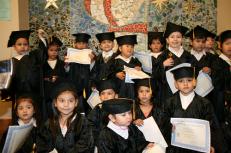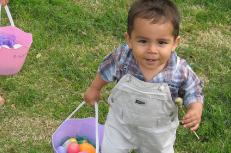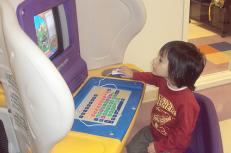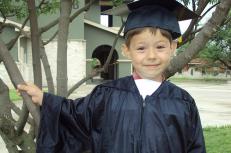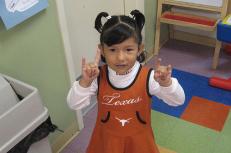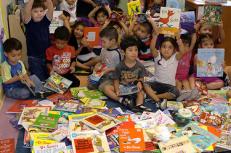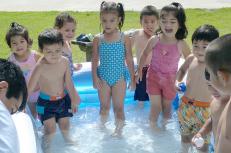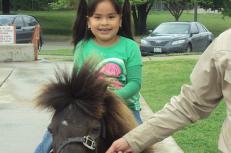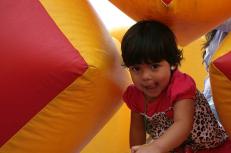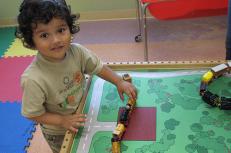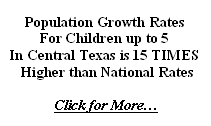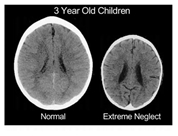The state of Texas currently has the fastest growing child population in the country, and studies show that the child population of Central Texas is growing at twice the state rate. Within this rapidly growing population, the majority of growth is among low-income Spanish-speaking households. Despite this growth, the state of Texas currently faces a proposed 99 percent cut to discretionary grant programs which would fund programs such as Pre-K Early Start and Early Childhood School Readiness programs in 2012-2013. Now more than ever, Central Texans must rise to the challenge presented by this disparity between funding made available and the change in demographics and recognize the long-lasting effects such disparity poses on the leaders of tomorrow.
Scientists who study early-childhood development and cognitive reasoning point to the first six years of life as a crucial time in the formation of the brain. Studies show that a healthy child who receives regular formative stimulation will experience a super-sponge phase of brain development whereby connective tissue forms trillions of connections to develop a fuller, healthier brain (see By The Numbers at right).
In contrast, the brain of a neglected child who experiences sensory deprivation does not grow to the same size as the healthy brain and shows abnormal development of the cortex (see The Facts on right). This shows us that neglect in early childhood affects the learning ability and future prospects of an individual throughout life.
As the education director for El Buen Samaritano, I recognize a great need in the population we serve for high-quality developmental education. Many of the children we serve come from households with limited financial resources, and often, their parents have very little formal education. When families enter our doors, they are often faced with a combination of obstacles related to poor job prospects, the overwhelming challenge of learning English, and the difficulties of adapting to a new culture. These parents seek to create better opportunities and futures for their families but often feel they are drowning under the constant pressure of providing basic needs for their children.
Among our hardworking and motivated clients, we see many challenges but also recognize great opportunity in the positive outcomes we see through our child development programs. In response to the growing need for early childhood interventions, El Buen Samaritano created a family-focused, multi-faceted approach to education and healthy-living programs. Children whose parents attend adult English as a Second Language (ESL), literacy, computer, and other classes at El Buen Samaritano attend the agency’s Child Learning Center, a semester-long program where children receive early exposure to learning activities to promote development of motor skills and to prepare them for success in learning.
Take Action
The program provides structured learning exercises and activities geared towards the developmental needs of children between the ages of six months and five years. The youngest participants, ages six months to two years, are led in activities to assist with response to voice, sounds, and images. Two- and three-year-olds engage in activities to develop strong communication skills as well as eye coordination, balance, and other motor skills. In the four- and five-year-old age group, children participate in a structured preschool-style curriculum where they prepare for entering school and learning to read. The daily activities focus on structured playtime, reading activities, and conceptual exercises related to shapes, colors, and other building blocks to prepare them for kindergarten.
Many of our families come from cultural traditions that emphasize informal, value-based learning over formal education and do not have full trust in the educational structure of the public school system. To these families, El Buen Samaritano is a trusted community center and gathering place that seeks to provide culturally sensitive, low-cost education and health resources. We educate the children in our programs, but we also view parents as primary influencers of the educational outcomes of the little ones. We focus on creating understanding and trust among parents in formal, primary education. We teach them that attendance in school is important and practice of educational concepts at home is imperative for children to retain new information and build upon the basic concepts they learn at the child learning center.
We are proud to see the many success stories that result from this family-oriented model of learning. A shining example came just a few weeks ago from a parent whose daughter, a Child Learning Center graduate, recently entered kindergarten. Dahlia, a parent of two young children, came to Austin with her husband nine years ago due to a lack of jobs and a dismal economic outlook in her home country of Mexico. While pregnant with her first child, she enrolled in English classes at El Buen Samaritano and learned of the pre-kindergarten program for the first time. She had previously not considered any type of early development program.
Her circumstances were challenging, to say the least. Her husband worked three jobs just to make ends meet and she attended English classes four times a week in order to create more opportunities for herself in Austin. Determined to improve the opportunities for her family, Dahlia continued through ESL classes until she became proficient in English and enrolled her daughter in the Child Learning Center throughout the time she was studying. Dahlia’s daughter attended the Child Learning Center during her critical developmental years and graduated in May 2010 with a class of twenty-five others.
In August, Dahlia’s daughter entered kindergarten and was quickly identified by her teacher as one of the most advanced students in the class. She has become a leader in her kindergarten class and is praised for excelling in the knowledge of colors, numbers, and letters. Dahlia’s daughter not only is exceeding academic expectations, but also is fully bilingual due to the emphasis placed on conversation and communication in her years attending the Child Learning Center. Dahlia’s family now faces brighter prospects for the future, and Dahlia feels confident that her daughter will continue to advance in school and use her love of learning and language skills to create promising professional opportunities.





